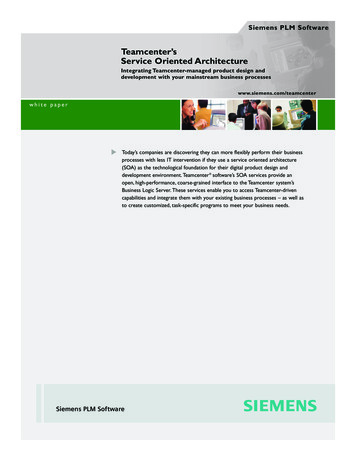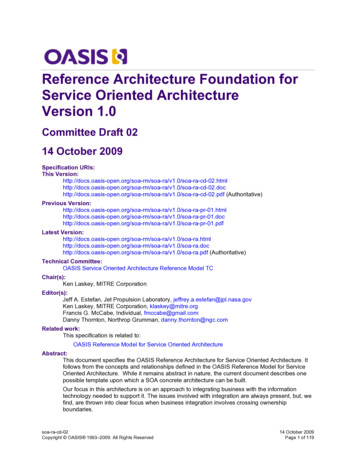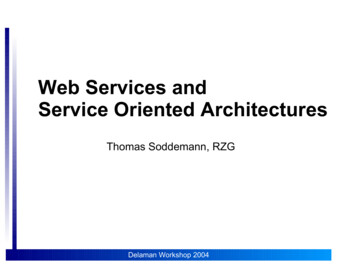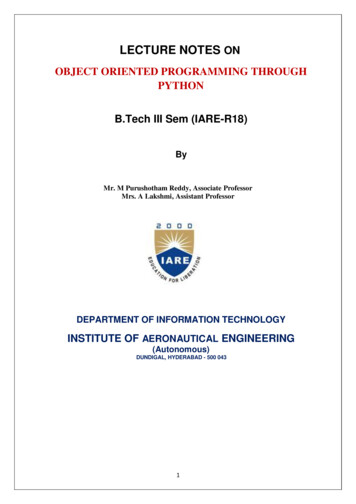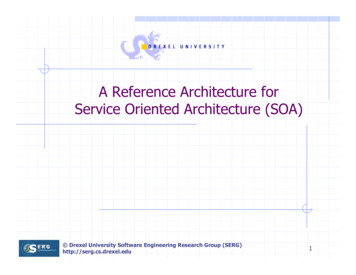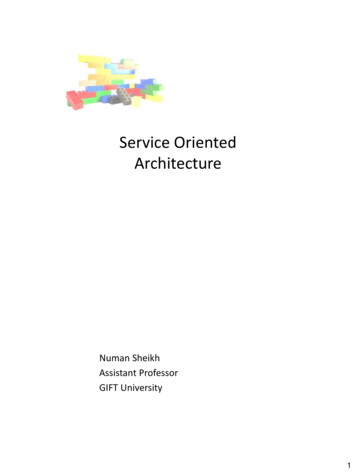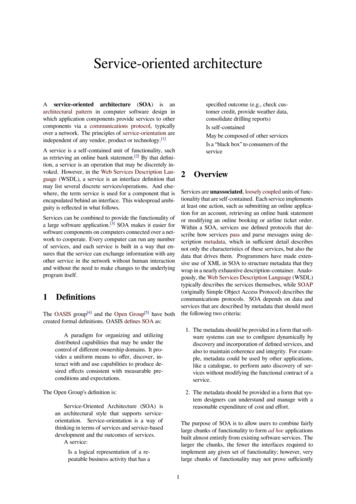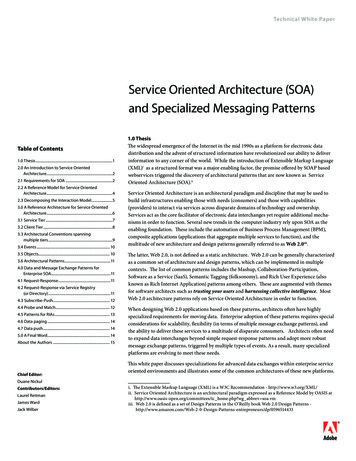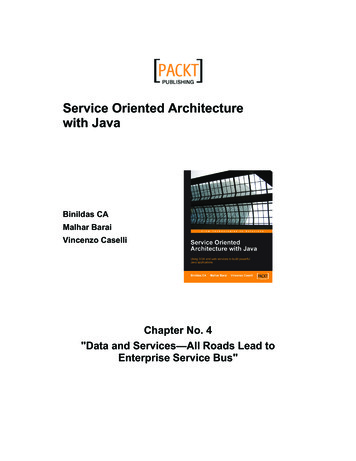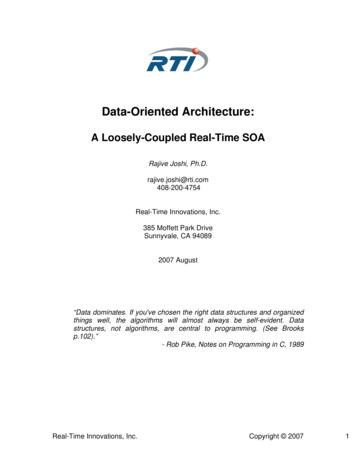
Transcription
Data-Oriented Architecture:A Loosely-Coupled Real-Time SOARajive Joshi, Ph.D.rajive.joshi@rti.com408-200-4754Real-Time Innovations, Inc.385 Moffett Park DriveSunnyvale, CA 940892007 August“Data dominates. If you've chosen the right data structures and organizedthings well, the algorithms will almost always be self-evident. Datastructures, not algorithms, are central to programming. (See Brooksp.102).”- Rob Pike, Notes on Programming in C, 1989Real-Time Innovations, Inc.Copyright 20071
AbstractAs more devices and systems get woven into the fabric of our networkedworld, the scale and the complexity of integration is growing at a rapidpace. Our existing methodologies and training for system software design,rooted in principles of object-oriented design, that worked superbly forsmall scale systems begin to break down as we discover operational limitswhich requires frequent and unintended redesigns in programs year overyear. Fundamentally, object-oriented thinking leads us to think in terms oftightly-coupled interactions that include strong state assumptions. Largescale distributed systems are often a mix of subsystems created byindependent parties, often using different middleware technologies, withmisaligned interfaces. Integrating such sub-systems using object-orientedthinking poses some fundamental challenges:(1) it is brittle to incremental and independent development, whereinterfaces can change without notice;(2) there is often an "impedance mis-match" between sub-systemsin the quantity and the quality of information that must beexchanged between the two sides;(3) there is a real need to dynamically adapt in real-time to networktopology reconfigurations and failures;(4) scalability, performance, and up-time cannot always becompromised in this dynamic environment .A different paradigm is needed in order to address these new challengesin a systematic manner.As the scale of the integration and complexity grows, the only unifyingcommon denominators between disparate sub-systems (generallynumbering more than two) are:(1) the data they produce and consume;(2) the services they use and offer.In order to scale, system software architecture must be organized arounda common "shared information model" that spans multiple systems. ThisReal-Time Innovations, Inc.Copyright 20072
leads us to the principle of "data-oriented" design: expose the data andhide the code.In this paper, we will discuss the principles of data-oriented thinking, anddiscuss why it offers an appropriate paradigm to address large scalesystem integration.We discuss the critical role played by the middleware infrastructure inapplying data-oriented design, and describe a generic data-orientedintegration architecture based on the data distribution service (DDS)middleware standard. We analyze popular architectural styles includingdata flow architecture, event driven architecture, and service orientedarchitecture from this perspective and establish that they can be viewedas specializations of the generic data-oriented architecture.Finally we illustrate how the data-oriented integration architecture wasused to rapidly develop a working demonstration of a real-time packagetracking system-of-systems, in a short time frame. The information modelis described once. The tool-chain is used to transform and manipulate theshared data model across disparate implementation technologies.Real-Time Innovations, Inc.Copyright 20073
Table of Contents1Introduction .51.11.2A REAL-TIME SYSTEM-OF-SYSTEMS SCENARIO . 5KEY CHALLENGES . 91.2.11.2.21.2.31.2.41.32SOLUTION DIMENSIONS. 14The Data-Oriented Design Paradigm.152.1THE PRACTICE OF DISTRIBUTED SYSTEM DESIGN . 152.1.22.1.32.22.3AN EXAMPLE . 24MIDDLEWARE INFRASTRUCTURE REQUIREMENTS . 26MIDDLEWARE INFRASTRUCTURE CHOICES . 27DATA-CENTRIC PUBLISH-SUBSCRIBE MIDDLEWARE INFRASTRUCTURE . 28Application Architecture: Applying the Data-Oriented Paradigm.334.1APPLICATION ARCHITECTURE STYLES . 334.1.14.1.24.1.34.24.3567Data-Oriented Programming Principles .20DOP and OOP.22DOP and Application Architecture .24The Role of the Middleware Infrastructure.253.13.23.34Loosely-coupled system design requires a paradigm shift .16Reality Check .18DATA-ORIENTED PROGRAMMING . 192.2.12.2.22.2.33Incremental and Independent Development.9Impedance Mismatch .11Dynamic Real-Time Adaptation .12Scalability and Performance.13Data Flow Architecture (DFA).35Event Driven Architecture (EDA) .36Client Server Architecture (CSA) .38DATA-ORIENTED INTEGRATION ARCHITECTURE . 40REAL-TIME SYSTEM-OF-SYSTEMS SCENARIO REDUX . 414.3.1Real-Time Package Tracking Scenario .424.3.2Data-Oriented Edge to Enterprise Integration Architecture .43Conclusions .50References .51Acronyms.53Real-Time Innovations, Inc.Copyright 20074
1 IntroductionThe growing popularity of cheap and widespread data collection “edge” devicesand the easy access to communication networks (both wired and wireless) isweaving in more devices and systems into the fabric of our daily lives. Ascomputation and storage costs continue to drop faster than network costs, thetrend is to move data and computation locally, using data distribution technologyto move data between the nodes as and when needed. As a result, the quantityof data, the scale of its distribution and the complexity integration is growing at arapid pace.The demands on the next generation of distributed systems and systems-ofsystems include being able to support dynamically changing environments andconfigurations, being constantly available, and being instantly responsive, whileintegrating data across many platforms and disparate systems.How does one systematically approach the design of such systems and systemsof-systems? What are the common unifying traits that can be exploited byarchitects to build systems that can integrate with other independently systems,and yet preserve the flexibility to evolve incrementally? How does one buildsystems that can be self aware and self-healing, and dynamically adapt tochanges in their environment? Can this be done on the scale of the Internet, andyet be optimized for the best performance that can be supported by theunderlying hardware and platform infrastructure? Can this be done withoutmagnifying the ongoing operational and administrative costs?These and related topics are the subject of this paper.1.1 A Real-Time System-of-Systems ScenarioLet us consider the air traffic control example of Figure 1. It involves a variety ofdisparate systems that must seamless operate as a whole.On the “edge” is a real-time avionics system inside the aircraft, which maycommunicate with a control-tower. The data flowing in this system is typically athigh rates, and time-critical. Violating timing constraints could result in the failureof the aircraft or jeopardize life or safety.Real-Time Innovations, Inc.Copyright 20075
The control tower is yet another independent real-time system, monitoringvarious aircraft in the region, coordinating their traffic flow, and generating alarmsto highlight unusual conditions. The data flowing in this system is still timesensitive for proper local and wide-are system operation, albeit it may a bit moretolerant of occasional delays.In our simplified example, the control tower communicates with the airportEnterprise Information System (EIS). The enterprise information system keepstrack of historical information, flight status, and so on and may communicate withmultiple control towers and other enterprise information systems. The enterprisesystem is not in the time-critical path, and therefore can be much more tolerant ofdelays on arrival of data; the data rates are also much lower compared to thosein a control-tower or an aircraft; however, the volume of data is far greaterbecause of the shear magnitude of the scaling factors involved (numbers ofairplanes, numbers of passengers, historical data, and so on). This enterprisesystem is responsible for synthesizing a composite “dashboard” view, such aspassenger information, flight arrival and departure status, and overall operationalhealth of the airport, from the real-time data originating from the “edge” systems(aircraft).Real-Time Innovations, Inc.Copyright 20076
Figure 1 The next generation of distributed systems is dynamic in nature, and must meetthe demands of constant availability, instant responsiveness, reliability, safety, andintegrity. They require integration of many platforms, systems, and their data.This “real-time edge-to-enterprise integration” scenario is representative of manyother application domains including the US Department of Defense’s (DoD)vision of net-centric operations and the global-information-grid (GiG), newinitiatives on intelligent transportation systems (ITS), telematics, ground trafficcontrol, homeland security, medical systems, instrumentation, industrialautomation, supply chain, simulation, unmanned vehicles, robotics, and systemsengineering, to name a few. Indeed, parallels to this “multi-tiered” edge toenterprise example can be easily seen around us---for example, instead of“airplane, control tower, airport” it could be “cell phone, cell tower, cell basestation”, or “power generation systems, power grid centers, power distributioncenters”.Real-Time Innovations, Inc.Copyright 20077
In business, many forces, including the rise of outsourcing, the need for businessagility, and the trend towards “on-demand” business, are leading to scenarioswhere independently developed systems must be quickly adapted and readapted to realize new business capabilities.The new emerging class of distributed applications is an integrated “system-ofsystems” (SoS), that brings together multiple independent systems to providenew capabilities. In general, the different classes of systems form a continuum;however for the purposes of this paper we broadly classify systems into threecategories, below.1. Edge systems. These are systems that touch the “real-world” to performvarious functions, including sensing, and actuation. Often, these systemsmust operate under “real-time” constraints---i.e. their correct operationdepends on meeting critical design requirements and timing constraints forvarious functions. The timescale is at machine-level, sometimes in theorder of microsecond resolution. Examples of edge systems includeinstrumentation, robots, radars, communication equipment etc.2. Enterprise systems. These are the “information technology” (IT) systemsthat traditionally include functions such as high-level user interaction,decision support, storage and retrieval of historical data. Often thesesystems provide the executive-level operational “dashboards” thatintegrate data from edge systems. Usually, these systems have “soft” realtime constraints, and the timescale is at a “human” response level in theorder of seconds, minutes, hours, days, etc. Examples of enterprisesystems include application servers, packaged applications, web-serversetc.3. Systems-of-Systems (SoS). These are distributed systems composed ofmany Edge, and/or Enterprise systems, including other SoS. Successfulexamples of SoS include the “World-Wide-Web (WWW)”, and “electronicmail”, that run on the public Internet. The US DoD’s GiG is envisioned as aSoS that integrates various DoD assets over the DoD’s private internet.SoS are loosely coupled, with many independent entry points, under independentcontrol domains, that effectively inter-operate to realize multiple objectives.Real-Time Innovations, Inc.Copyright 20078
1.2 Key ChallengesSoS must effectively deal with various issues, including (1) crossing trustboundaries, where each system is controlled and managed independently, andinvolves social, political and business considerations; (2) managing quantitativeand qualitative differences in the data exchange and performance; for examplean “edge” system often carries time-critical data at high rates, some of whichmust eventually trickle into an “enterprise” system; (3) operating across disparatetechnology stacks, design paradigms, and life-cycles of the different systems.Next, we examine some of the key technical challenges in building successfulSoS, and leave the non-technical aspects for discussion elsewhere.1. Incremental and Independent Development arising from the fact thatsystems are generally developed and evolved independently.2. Impedance Mismatch arising from the non-functional differences in theinformation exchange between systems – both in the quantity and thequality of the data exchange.3. Dynamic Real-Time Adaptation arising from the fact that the environmentscan change dynamically, and it is not practical to have a centralizedadministrator or coordinator.4. Scalability and Performance, arising from the need to support larger SoSas more resources are introduced, with minimal overhead.1.2.1 Incremental and Independent DevelopmentEach system can be under an independent domain of control---sometimes bothfrom an operational as well as management perspective. Different systems maybe developed independently. In the “systems engineering” world, it is commondevelopment practice to switch a system or a sub-system transparently from a“simulated” version to an independently developed “real” version and vice-versa.Furthermore, deployed systems continuously undergo incremental evolution anddevelopment as capabilities are added or extended.By their very nature, the systems under consideration are loosely-coupled--minimal assumptions can be made about the interface between two interactingReal-Time Innovations, Inc.Copyright 20079
sub-systems. The integration should be robust to independent changes in eitherside of an interface. Ideally, changes in one side should not force changes on theother side. This implies that the interface should contain only the invariants thatdescribe the interaction between the two-systems. Since, behavior isimplemented by each independent system; the interface between them must notinclude any system specific state or behavior (Figure 2). The remaining invariantis the information exchange between the two systems.Figure 2 The interface between “loosely-coupled” independent systems should notinclude any system-specific behavior or state. It can include the “data model” of theinformation exchanged between the systems, and the role played by a system.An information exchange can be described in terms of1. the information exchange “data model”2. the roles of “producer” and “consumer” participating in the informationexchangeReal-Time Innovations, Inc.Copyright 200710
Thus, when dealing with loosely coupled systems, a system’s interface can bedescribed in terms of the “data model” and the “role” (producer or consumer) thesystem plays in the information exchange. Additional assumptions can break theloose coupling.1.2.2 Impedance MismatchThe systems on either side of an interface (Figure 2) may differ in the qualitativeaspects of their behavior, including differences in data volumes, rates, timingconstraints, and so on.We use the term “impedance mismatch” to connote all the non-functionaldifferences in the information exchange between two systems. Figure 3illustrates the impedance mismatch between edge and enterprise systems in thecurrent state of affairs.Real-Time Innovations, Inc.Copyright 200711
Figure 3 Impedance mismatch between today’s edge and enterprise systems arises from anumber of factors, including differences in data rates, timing constraints, life-cycle of data,persistency, and the differing technology stacks.The non-functional aspects of a system’s interface (data model and role, Figure2) can be conceptually captured as a quality-of-service (QoS) aspect associatedwith the system’s role. A producer may “offer” some QoS, while a consumer may“request” some QoS for an interface. A producer and consumer can participate ininformation exchange using that interface if-and-only-if their QoS are“compatible”. This approach allows us to conceptually model and deal with theimpedance mismatch between independent systems.1.2.3 Dynamic Real-Time AdaptationReal-Time Innovations, Inc.Copyright 200712
The independently managed systems can appear and disappearasynchronously, as they are started, shutdown, rebooted, or reconfigured. Theenvironment can change dynamically, causing systems to react differently.Physical communication links between systems may go down or may beunreliable---such failures may be indistinguishable from system failures at theother end of the communication link [Waldo 1994].In general, it is not possible or not practical to have a centralized administrator orcoordinator of the various systems, especially at the granularity of asynchronouschanges that may occur dynamically. Thus, each system must detect and reactto dynamic changes as they occur. The responsibility of detecting dynamicchanges in connectivity is best delegated to the information exchangeinfrastructure provided by the computing environmentThe information exchange infrastructure typically includes the network transporthardware, the computing hardware, the operating system, and thecommunications middleware, on top of which an application runs.Ideally, the information exchange infrastructure would be “self-aware” in thesense of being able to detect and inform the systems when changes occur intheir connectivity with other systems.1.2.4 Scalability and PerformanceScalability refers to the ability to handle proportionally more load, as moreresources are added. Scalability of the “information-exchange” infrastructure thusrefers to the ability to take advantage of underlying hardware and networkingresources, and the ability to support larger SoS as more physical resources areadded. From an component developer’s perspective, this translates to the abilityof the information exchange infrastructure to naturally scale from systemscomprising of one-producer and one-consumer pair, to one-to-many, many-toone, and many-to-many producers and consumers. A related notion is that of“administrative scalability” of the infrastructure---how the infrastructureadministrative load increases as the number of components increases. Ideally,this should be at a minimum.Performance refers to the ability to support information exchange with minimaloverhead. Performance considerations typically include latency, jitter, throughput,and processor loading.Real-Time Innovations, Inc.Copyright 200713
Scalability and performance are practical concerns that determine the suitabilityand the justification of a SoS for business objectives in the first place. Theydepend heavily on the implementation of the underlying information exchangeinfrastructure.1.3 Solution DimensionsThe key technical challenges in building SoS can be tackled among the followingdimensions.1. Design Paradigm. Traditional “object-oriented” design works well for “tightlycoupled” systems where strong state assumptions about the interaction areacceptable. Indeed it is possible to avoid state assumptions with objectorientation as well; however that is not the general practice or guidance, andstate assumptions invariably do trickle into the interface specification. Forloosely-coupled systems, a new “data-oriented” design paradigm (see theSection “The Data-Oriented Design Paradigm”) provides a more suitableframework to address the challenges of (a) incremental and independentdevelopment; (b) impedance mismatch.2. Middleware Infrastructure. It refers to the information exchange infrastructure.As noted during the discussion the technical challenges, the middlewareinfrastructure that take on important responsibilities, and provide keycapabilities that can ease and facilitate the construction of SoS anddistributed systems in general. The middleware infrastructure is the place toaddress the challenges of (a) dynamic real-time adaptation; and (b) scalabilityand performance. It can also facilitate integration by directly supporting adesign paradigm for loosely-coupled systems, and thus aid in addressing (c)incremental and independent development; (b) impedance mismatch. Wediscuss this in the Section “The Role of the Middleware Infrastructure”.3. Application Architecture. It refers to the overall architecture of a SoS to realizebusiness objectives. It encompasses the overall interaction patterns, commondata models, QoS, and application specific semantics. Several approachesare prevalent for the application architecture, including client-serverarchitecture (CSA), event-driven architecture (EDA), and so on. Theapplication architecture is anchored to the design paradigm, and utilizes theunderlying middleware infrastructure. Application architecture is the place toaddress the challenges of (a) impedance mismatch; (b) dynamic real-timeReal-Time Innovations, Inc.Copyright 200714
adaptation at an integrated SoS level. We discuss this in the Section”Application Architecture: Applying the Data-Oriented Paradigm”, and finallyillustrate a concrete SoS integration example that ties all the conceptstogether.The rest of this paper discusses each of these solution dimensions in depth.2 The Data-Oriented Design ParadigmSystem design, in general, may be viewed as a collection of interconnectedcomponents. Depending on the context and granularity of scale, a componentmay be, for example, an entire system (in a SoS), or an application, or a process,or a library module. Let us examine the underlying design principles that canprovide us the theoretical foundation for dealing with the challenges introduced inSection “Key Challenges”.2.1 The Practice of Distributed System DesignWhen we examine the practice of system design, we can identify two linesprimary schools of thought, distinguished along the lines of “tight-coupling” vs.“loose-coupling” of components. These have been applied to the design of bothlocal and distributed processing systems.2.1.1.1 Tightly-coupled system design is promoted by a familiar paradigmTight-coupling refers to making strong assumptions about the interface ofinterconnected components. Changes in one component’s interface typicallyhave a significant impact on the components that interact with it.Our existing methodologies and training for system software design, rooted inprinciples of object-oriented design, lead to tightly-coupled interactions. In theobject-oriented approach, it is common practice to make strong assumptionsabout the interaction state in the interface; the paradigm encourages the notionof “distributed state” across the interacting objects. This works superbly on thesmall scale for “local processing” where the components live in a share acommon “logical” address space, the communication latency is negligible,memory can be accessed by shared pointers or references, and there is no “real”Real-Time Innovations, Inc.Copyright 200715
indeterminism about how much of a computation completed when failures occuror when operations are invoked---however these assumptions are not valid fordistributed system where components do not share a single logical addressspace [Waldo 1994].Since the object-oriented programming paradigm is so widely popular andsuccessful for local processing, it is only natural that we apply it for distributedprocessing as well. The idea is to wash away the differences between local anddistributed processing, and treat the system as a logical whole around a logicaldistributed shared memory model. The defining mantra for this approach iscaptured by Sun Microsystems tag line: “The network is the computer”.This path has lead to various endeavors, including the work on distributedoperating systems, distributed shared memory, remote-procedure calls (or RPC),common request-broker architecture (CORBA), enterprise java beans (EJB),simple-object access protocol (SOAP), and approaches for clustering and loadbalancing to scale the performance of the “logically” centralized computing modelacross distributed nodes. It is now well established in the literature that it is amistake to wash away the differences between remote and local objects [Waldo1994], and at best this approach only works for small and tightly managedenvironments.Indeed, object-oriented design is an appropriate paradigm for components thatare intrinsically tightly coupled, and allows one to take advantage of theperformance optimizations afforded by direct memory access, lower latencies,simple failure modes, and centrally managed concurrency and resources.Object-oriented system design has been used with success in tightly controlledand managed distributed environments. However, tightly-coupled solutions aremore difficult to modify since changes made in one place cause changes to bemade somewhere else. At the best they require a re-test of the entire system orsystem-of-systems to make certain nothing was broken. They do not robustlyscale up when the assumptions of centralized control and management no longerhold [Waldo 1994], as is the case with the new generation of distributed systems(eg SoS).2.1.2 Loosely-coupled system design requires a paradigm shiftReal-Time Innovations, Inc.Copyright 200716
Our existing object-oriented methodologies and training for system softwaredesign that worked superbly for local or centralized processing begin to breakdown for distributed or decentralized systems.When components live in different address spaces, the differences incommunication latency and memory access among components becomesignificant. Working with components in multiple address spaces also introduces“true” indeterminism in failure modes [Waldo 1994], and in the invocation ofconcurrent operations [Lamport 1978]. Such systems must deal with partialfailures, arising from failure of independent components and/or communicationlinks; in general the failure of a component is indistinguishable from the failure ofits connecting communication links. In such systems, there is no single point ofresource allocation, synchronization, or failure recovery. Unlike local process, adistributed system may simply not be in a consistent state after a failure.The “fallacies of distributed computing” [Van Den Hoogen 2004], summarizedbelow, capture the key assumptions that break down (but still are often made byarchitects) when building distributed systems.1. The network is reliable.2. Latency is zero.3. Bandwidth is infinite.4. The network is secure.5. Topology doesn't change.6. There is one administrator.7. Transport cost is zero.8. The network is homogeneous.A different paradigm is needed to build distributed systems, which by nature, are“loosely-coupled”. This has been clearly noted in the literature [Waldo 1994].“Programming a distributed application will require thinking about theproblem in a different way than before it was thought about when thesolution was a non-distributed application.:One consequence of the view espoused here is that it is a mistake toattempt to construct a system that is “objects all the way down” if oneunderstands the goal as a distributed system constructed of the same kindof objects all the way down.”- Waldo, Wyant, Wollrath, Kendall, 1994Real-Time Innovations, Inc.Copyright 200717
An appropriate paradigm for building “loosely-coupled” systems can be found inthe principles of “data-oriented programming” [Kuznetsov], and discussed in thefollowing Section “Data-Oriented Programming”. It is based on the observation that the “datamodel” is the only invariant (if any) in a loosely coupled system (Figure 2), andshould be exposed as a first-class citizen----in other words “data” is primary, andthe operations on the data are secondary! Since a common “logical” addressspace cannot be assumed, the information exchange between components isbased on a message passing interaction paradigm.When applied to distributed systems, the defining mantra for a loosely-coupledapproach may be captured by: “The computer is the network”, whichacknowledges the fact that distributed compu
data flow architecture, event driven architecture, and service oriented architecture from this perspective and establish that they can be viewed as specializations of the generic data-oriented architecture. Finally we illustrate how the data-oriented integration architecture was used to rapid

